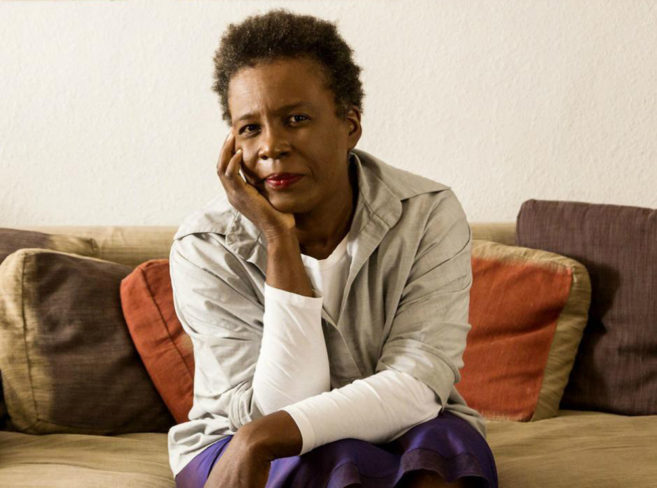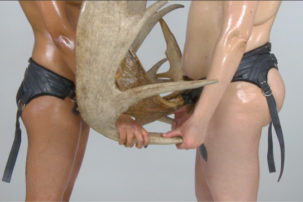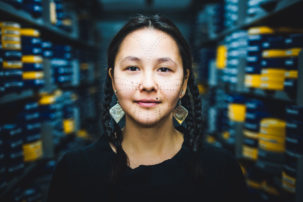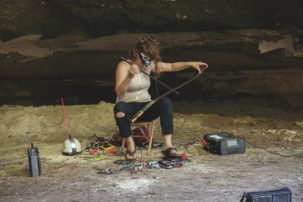Behind the doors of Qaumajuq, the newly constructed Inuit art centre at the Winnipeg Art Gallery opening next week, is an exhibition of Inuit art like no other: “INUA.” The exhibition is an expansive collection of contemporary Inuit art in a genre-defying range of mediums from Inuit artists across the circumpolar world. The diversity of innovative contemporary Inuit art is something to celebrate in itself, but there’s also something else that makes this show even more special—it just happens to be the most openly queer Inuit art exhibition ever. And while this is not exclusively queer Inuit art exhibition, the organizers say that including and celebrating 2SLGBTQ+ Inuit artists was always part of the plan.
“We don’t know if this is the queerest exhibition ever. We just know it’s the most openly queer exhibition ever because that information didn’t get included in the largely written art histories from before. It was probably known, it’s not like we’re just now having queer artists for the first time,” says “INUA” curator Heather Igloliorte. “It’s just that information about people wasn’t selling works to the art market at the time, and so it wasn’t included in the literature. If you leave that part out, then you’re actually denying a part of their humanity.”
“INUA” means “life” or “spirit” in Inuktitut, and it is also an acronym for Inuit Nunangat Ungammuaktut Atautikkut (Inuit Moving Forward Together). Each of the exhibition’s four curators—Heather Igloliorte, Krista Ulujuk Zawadski, Kablusiak and asinnajaq—comes from one of the four Inuit homelands within Canada. The group wanted to showcase an accurate representation of contemporary Inuit artists that spans geographic divides, ignores colonial borders and celebrates Inuit gender and sexual diversity.
“We really wanted to create a safe space and help to show our communities that our artists are accepted in all forms and walks of life. 2SLGBTQ+ Inuit are part of our society and they are an important aspect of our culture and community. It takes courage to be out in our communities. We want people to know that they can be themselves and still be included,” says Krista Ulujuk Zawadski.
The exhibition features 100 works by over 80 artists from across the North, with contributions coming from collaborators as far away as Alaska and Greenland, as well as from many southern Inuit living in urban areas. The curators sought to include works from artists in all different points of their careers. They looked for forward-thinking artists who use mediums not often represented in the Inuit art canon.
“Seeing other queer Inuit artists was not something that I was ever exposed to going through school. But I think if I had experienced that, it probably would have changed the trajectory of my practice. But I’m glad it exists now and I’m glad to be a part of this changemaking,” says curator Kablusiak.
Not everyone whose work is featured in the show is queer, but for the “INUA” curators, it was important to celebrate 2SLGBTQ+ Inuit artists without separating them from the others. They believed it was crucial to show that queer Inuit artists are an integral component of contemporary Inuit art—and a part of the larger Inuit community.
“The theme of the exhibition is about us all moving forward together, collectively as Inuit,” says asinnajaq. “And the only way to do that is with everyone. So it’s important to do our best to make a representation that’s true to who we are, and that can mean including voices that we feel haven’t been heard as much, people within our community who maybe we don’t listen to as much.”
Many Inuit communities are deeply religious places, and life outside of heteronormativity is sometimes not accepted. Some politicians in Nunavut have been vocal that queer identities are incongruous with the Inuit way of life — a position that Igloliorte and the other curators flatly reject.
“That shame comes from outside of Inuit culture. That modesty [and those] limits on sexuality and expression come from outside of Inuit culture. We wanted to make this exhibition in the most Inuit way that we could, to think outside of some of those things that have been imposed on us rather than from an Inuit way of thinking or approaching something.”
 Glenn Gear, photo courtesy of artist.
Glenn Gear, photo courtesy of artist.
One of the larger pieces of art in the INUA exhibition is housed inside of a familiar site to many northerners; it’s a sea can, also known as a shipping container. Inside these large metal boxes, cargo is shipped across the North, and many wind up becoming backyard sheds or storage for community members.
Inside of this sea can though, you won’t find freight—instead you’ll discover Iluani/Silami (It’s full of stars) (2021), an installation by Inuk artist Glenn Gear. The installation features two eight-by-twenty-foot murals flanking a video projection porthole at the containers end. Each of the murals depict people with the heads of animals found within the Inuit homeland of Nunatsiavut. On one side the figures participate in more traditional activities like hunting, on the other side the human-animal hybrids inhabit a futuristic city. At the far end of this dimly lit sea can are projections of the aurora borealis and scenes of Northern Labrador. Artist Glenn Gear says he hopes that once visitors are drawn into the container, they will feel transported to another world.
“I want to create a kind of meditation pod, or a portal into another dimension. There’s also a sound element that I’m currently working on that’s going to be very simple, but meditative. So when you enter this can, you’re kind of transported into another dimension,” explains Gear. “It’s going to be kind of illuminating, but kind of dark at the same time. I’m hoping that it will draw you in.”
Gear is of settler and Inuit heritage. His father is from Nunatsiavut, in Northern Labrador, and his mother is of Irish Newfoundland descent. Gear now lives in Montreal with his partner of nearly 30 years. He appreciates that the exhibition is both diverse and inclusive.
“This exhibition is very reflective of where contemporary art is right now. And I think the Canadian art scene has a little bit of catching up to do. But, you know, we’ve always been innovators and we use technology in unexpected and wonderful ways, and [we’re] part of what I think is a culture of problem solving,” says Gear. “I think there are preconceptions and ideas of who Inuit are supposed to be. And the fact is, we’re very young and also very urban, and our demographic makeup [in this exhibition] reflects that, certainly in terms of our gender identity and our queerness that is very evident in the show. It is reflective of where the culture is right now. And it’s really exciting that this exhibition is providing a place that reflects where we are, and pushes things ahead to where they might be going.”
Gear, who identifies as Indigiqueer—a term intersecting queer and Indigenous identities—is thrilled to stand among such a diverse representation of Inuit in this exhibition. He says not only is Inuit art changing, but so are Inuit communities, and he hopes that this exhibition reflects these changes.
“It’s really wonderful to see not only such a diversity of work, but also so many Inuit working in different mediums and using forms that go beyond the expected sculpture or printmaking or drawing,” says Gear. “It’s wonderful to be a part of a very very queer, Inuit exhibition. It’s an exploration of different voices. And we see regional differences, but also differences in gender identity or sexual expression come out through the works in different ways.”
For Gear, there is something special, something unique about being both Inuk and queer.
“There’s a synergy, a crossing over or contact point, between this idea of home and Land and being queer. So many times in our day-to-day lives, we compartmentalize, but being Inuit and being queer at the same time is inseparable for me,” Gear explains. “Even when I’m not explicitly doing doing work that’s overtly queer or even overtly Inuk—whatever that is—it’s still embedded. I’m a queer Inuk. And by virtue of that, everything I create is kind of queer and Inuk.”
During the 1990s and early 2000s, 2SLGBTQ+ First Nations and Métis artists struck out a path of their own. While their works weren’t always implicitly queer, they forged a trail for many 2SLGBTQ+ Indigenous artists. Inuit artists had a different art market and a different trajectory, and while queer Inuit have always been making art, the conversation around queer Inuit art is still in its early stages. Gear says that he has been inspired by some of these artists and thinkers, particularly poet and novelist Joshua Whitehead’s writings on being Indigiqueer.
“I really feel the terminology Indigiqueer—it’s something I feel akin to. I like that queer comes out of a kind of political resilience, and it’s a word that has been reclaimed, so there’s a sense of agency to it. The term has a whole history of bringing together two things and says they’re inseparable, and it includes ways for us to inhabit these new Indigenous spaces.”
Gear hopes that “INUA” will help young 2SLGBTQ+ Inuit artists see that there’s room for a diversity of voices, and that they don’t have to make art in predictable or expected ways.
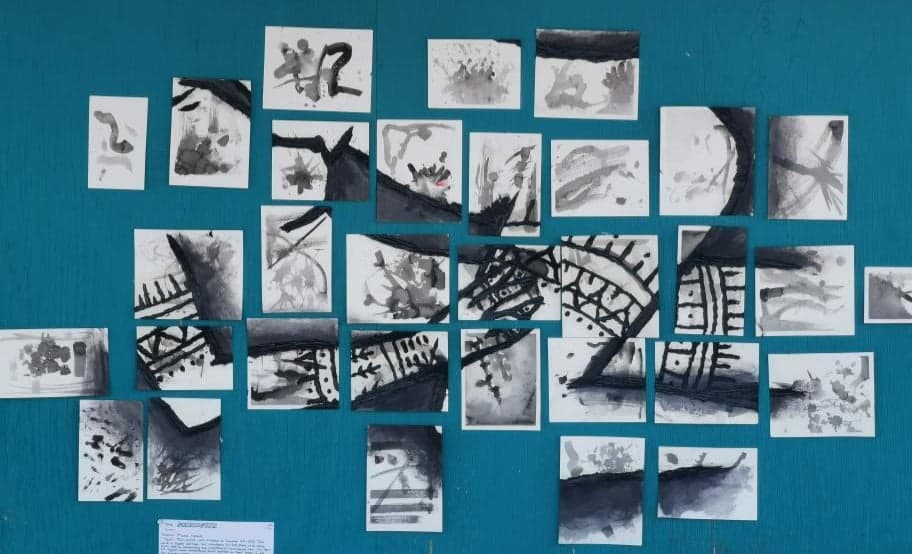 Siku Rojas, SkinNskin, 2020, water colours and oil paint on paper, photo courtesy of artist.
Siku Rojas, SkinNskin, 2020, water colours and oil paint on paper, photo courtesy of artist.
Queer Inuit art is not found only in galleries and museums; it is everywhere you find Inuit artists—North and South. With each passing generation, gender and sexually diverse people are becoming increasingly accepted. This is true of Inuit communities as well. While there’s still a long way to go, more and more Inuit are feeling empowered enough in their communities to be able to come out, and this is being reflected in contemporary Inuit art.
From coast to coast to coast, a young generation of 2SLGBTQ+ Inuit artists are starting out on their careers. From Qaumajuq in Winnipeg to more than 2000 kilometers to the northeast in Iqaluit, you will find Ivviulutit, a youth group for young queer Inuit and other BIPOC youth. The name Ivviulutit roughly translates to “be as you are” in Inuktitut. This past February, Ivviulutit held their first art show in Iqaluit.
Siku Rojas, 18, attended Ivviulutit’s show to sell their prints. They are mainly self-taught, relying on their lived experience and YouTube art tutorials to develop their practice. In their work, they like to play around with the genders of the people they are depicting to challenge assumptions and start conversations.
“I try to connect my art to the LGBTQ community and to hopefully help youth feel connected, because I didn’t really grow up seeing people in the LGBTQ community or at least not seeing them be open about it. I always knew it was kind of okay, but I didn’t see other Indigenous people who were LGBTQ.”
Rojas says that coming out as nonbinary and pansexual allowed them to embrace their traditions and identity.
“I really feel like I’m trying to connect more to how life was like back before Europeans came to the North, because there’s so much we lost and so much we have not fully been able to touch and get connected with. And I don’t think we can fully. But for me, my coming out and being part of the LGBTQ community means being connected more to how life was before we adopted a Western life and perspective. It makes me feel a lot better. It makes me feel like I’m being true to my Inukness.”
Rojas sells their prints and paintings in Iqaluit and has recently gotten into beading. They say they want to pursue a career in the arts and maybe attend a postsecondary art school someday. They say that Inuit communities are slowly changing and becoming more accepting, but still have a long way to go. Still Rojas says they are hopeful, and that seeing such a prominent Inuit art exhibition like “INUA” featuring so many 2SLGBTQ+ Inuit artists is inspiring.
“It shows things are changing. I really hope there’ll be a lot of virtual shows of the exhibition so we can check it out, because that sounds really beautiful.”
“INUA,” the inaugural exhibition of Qaumajuq, opens March 27, with virtual tours of Qaumajuq beginning March 25.

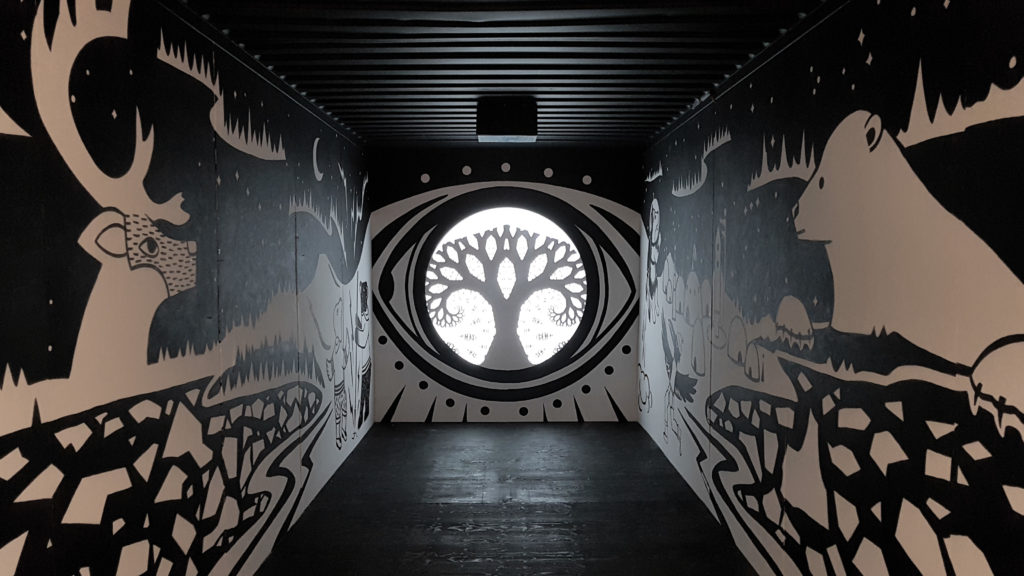 Glenn Gear, Iluani/Silami (It's full of stars), 2021, acrylic paint on canvas and projection, photo courtesy of artist.
Glenn Gear, Iluani/Silami (It's full of stars), 2021, acrylic paint on canvas and projection, photo courtesy of artist.
